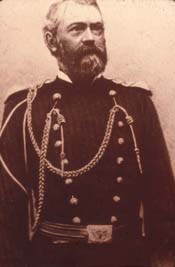|
The Tower was an object of curiosity to early white explorers. Although fur traders and others probably saw the gigantic formation, no records survive to confirm this suspicion. Lieutenant G. K. Warren’s expedition of 1855 passed through the Black Hills en route from Fort Laramie to Fort Pierre; it is unlikely they were close enough to see the Tower. In 1857, Warren, accompanied by Dr. F. V. Hayden and others, started from Fort Laramie to explore the Black Hills and then, returned to the Missouri via the Niobrara River. At Inyan Kara, they met a large party of Sioux who threatened to attack if they attempted to advance farther. While there Warren reported seeing the "Bear's Lodge" and "Little Missouri Buttes" to the north through a powerful spyglass. It is not known if he was referring to the Bear Lodge Mountains or to the Tower itself. The explorers retraced their route 40 miles and took another route eastward instead of the one originally planned. Captain W. F. Raynolds' Yellowstone Expedition passed through the Black Hills region two years later. His topographer, J. T. Hutton, and the Sioux interpreter, Zephyr Recontre, reached the Tower on July 20 and returned to the expedition's camp on the Little Missouri River. Despite being in the region, neither Warren nor Raynolds left descriptions of the formation. 
It remained for the U.S. Geological Survey party to call attention to the uniqueness of the Tower. In 1875, after General Custer's claims of gold in the Black Hills, Colonel Richard Irving Dodge led a new expedition of the area. He described the Tower as "one of the most remarkable peaks in this or any country." Henry Newton (1845-1877), geological assistant to the expedition, wrote: It was during this expedition that the name "Devils Tower" originated. In his 1876 book, The Black Hills, Dodge called it "Devils Tower," explaining: "The Indians call this shaft The Bad God’s Tower, a name adopted with proper modification, by our surveyors." Newton, whose published work on the survey appeared in 1880, explained that the name Bear Lodge (Mato Tipila) "appears on the earliest map of the region, and though more recently it is said to be known among the Indians as 'the bad god's tower,' or in better English, 'the devil’s tower...'" Although many maps and documents still referred to the formation as "Bear Lodge," Dodge's book became immensely popular and the new name took root in the public's mind. The issue of the Tower's name is a source of controversy for many people. Almost all of the American Indian names for the Tower are associated with a bear. In the Lakota language, bad god or evil spirit is wakansica whereas the word for black bear is wahanksica - this fact suggests that Dodge's party simply mistranslated the Native American name for the Tower.1 Recently, tribal organizations have lobbied for a change to the name of the Tower (including the park and nearby area) to Bear Lodge. The national park provides more information about the proposal to change the name for those interested to learn more. 1 - Standing Witness, Devils Tower National Monument A History - Jeanne Rogers, 2008 Information originally drafted by Ray H. Mattison, Historian for the National Park Service, 1955 |
Last updated: April 24, 2025
